MAP1LC3A Recombinant Rabbit Monoclonal Antibody [ST47-03]

cat.: ET1609-26
| Product Type: | Recombinant Rabbit monoclonal IgG, primary antibodies |
|---|---|
| Species reactivity: | Human, Mouse, Rat |
| Applications: | WB, IF-Cell, FC, IP |
| Clonality: | Monoclonal |
| Clone number: | ST47-03 |
| Form: | Liquid |
| Storage condition: | Shipped at 4℃. Store at +4℃ short term (1-2 weeks). It is recommended to aliquot into single-use upon delivery. Store at -20℃ long term. |
| Storage buffer: | 1*TBS (pH7.4), 0.05% BSA, 40% Glycerol. Preservative: 0.05% Sodium Azide. |
| Concentration: | 1ug/ul |
| Purification: | Protein A affinity purified. |
| Molecular weight: | Predicted band size: 14 kDa |
| Isotype: | IgG |
| Immunogen: | Synthetic peptide within Human MAP1LC3A aa 81-121 / 121. |
| Positive control: | HeLa treated with 50μM Chloroquine for 18 hours cell lysate, C2C12 cell lysate, C2C12 treated with 50μM Chloroquine for 18 hours cell lysate, C6 cell lysate, C6 treated with 50μM Chloroquine for 18 hours cell lysate, SH-SY5Y, Neuro-2a, C6. |
| Subcellular location: | Cytoplasm, Endomembrane system, Cytoplasmic vesicle, Microtubule, Membrane. |
| Recommended Dilutions:
WB IF-Cell FC IP |
1:1,000-1:2,000 1:100 1:1,000 1-2μg/sample |
| Uniprot #: | SwissProt: Q9H492 Human | Q91VR7 Mouse | Q6XVN8 Rat |
| Alternative names: | ATG8E Autophagy-related protein LC3 A Autophagy-related ubiquitin-like modifier LC3 A LC3 LC3A MAP1 light chain 3 like protein 1 MAP1 light chain 3-like protein 1 MAP1A/1B light chain 3 A MAP1A/MAP1B LC3 A MAP1A/MAP1B light chain 3 A MAP1ALC3 MAP1BLC3 Map1lc3a Microtubule associated proteins 1A/1B light chain 3 Microtubule-associated protein 1 light chain 3 alpha Microtubule-associated proteins 1A and 1B, light chain 3 Microtubule-associated proteins 1A/1B light chain 3A MLP3A_HUMAN |
Images
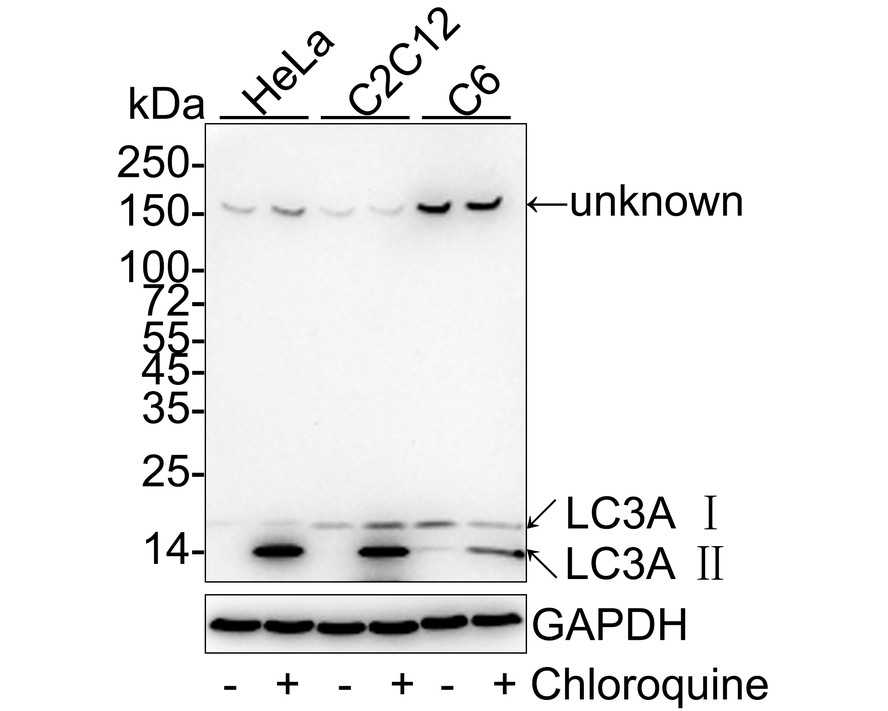
|
Fig1:
Western blot analysis of MAP1LC3A on different lysates with Rabbit anti-MAP1LC3A antibody (ET1609-26) at 1/1,000 dilution. Lane 1: HeLa cell lysate Lane 2: HeLa treated with 50μM Chloroquine for 18 hours cell lysate Lane 3: C2C12 cell lysate Lane 4: C2C12 treated with 50μM Chloroquine for 18 hours cell lysate Lane 5: C6 cell lysate Lane 6: C6 treated with 50μM Chloroquine for 18 hours cell lysate Lysates/proteins at 20 µg/Lane. Predicted band size: 14 kDa Observed band size: 14/16 kDa Exposure time: 3 minutes; ECL: K1801; 4-20% SDS-PAGE gel. Proteins were transferred to a PVDF membrane and blocked with 5% NFDM/TBST for 1 hour at room temperature. The primary antibody (ET1609-26) at 1/1,000 dilution was used in 5% NFDM/TBST at 4℃ overnight. Goat Anti-Rabbit IgG - HRP Secondary Antibody (HA1001) at 1/50,000 dilution was used for 1 hour at room temperature. |
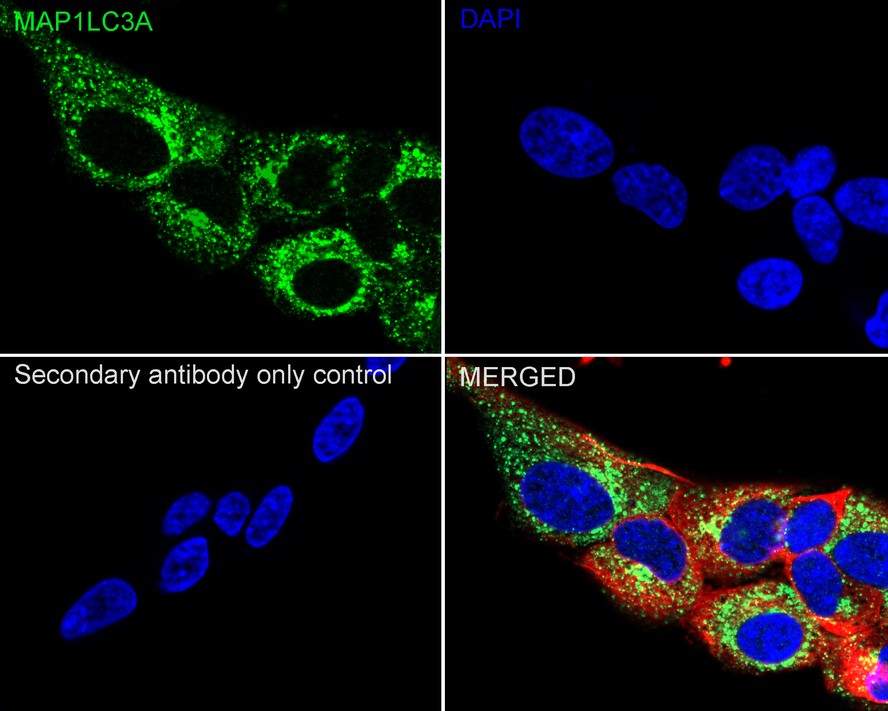
|
Fig2:
Immunocytochemistry analysis of SH-SY5Y cells labeling MAP1LC3A with Rabbit anti-MAP1LC3A antibody (ET1609-26) at 1/100 dilution. Cells were fixed in 4% paraformaldehyde for 15 minutes at room temperature, permeabilized with 0.1% Triton X-100 in PBS for 15 minutes at room temperature, then blocked with 1% BSA in 10% negative goat serum for 1 hour at room temperature. Cells were then incubated with Rabbit anti-MAP1LC3A antibody (ET1609-26) at 1/100 dilution in 1% BSA in PBST overnight at 4 ℃. Goat Anti-Rabbit IgG H&L (iFluor™ 488, HA1121) was used as the secondary antibody at 1/1,000 dilution. PBS instead of the primary antibody was used as the secondary antibody only control. Nuclear DNA was labelled in blue with DAPI. Beta tubulin (HA601187, red) was stained at 1/100 dilution overnight at +4℃. Goat Anti-Mouse IgG H&L (iFluor™ 594, HA1126) was used as the secondary antibody at 1/1,000 dilution. |
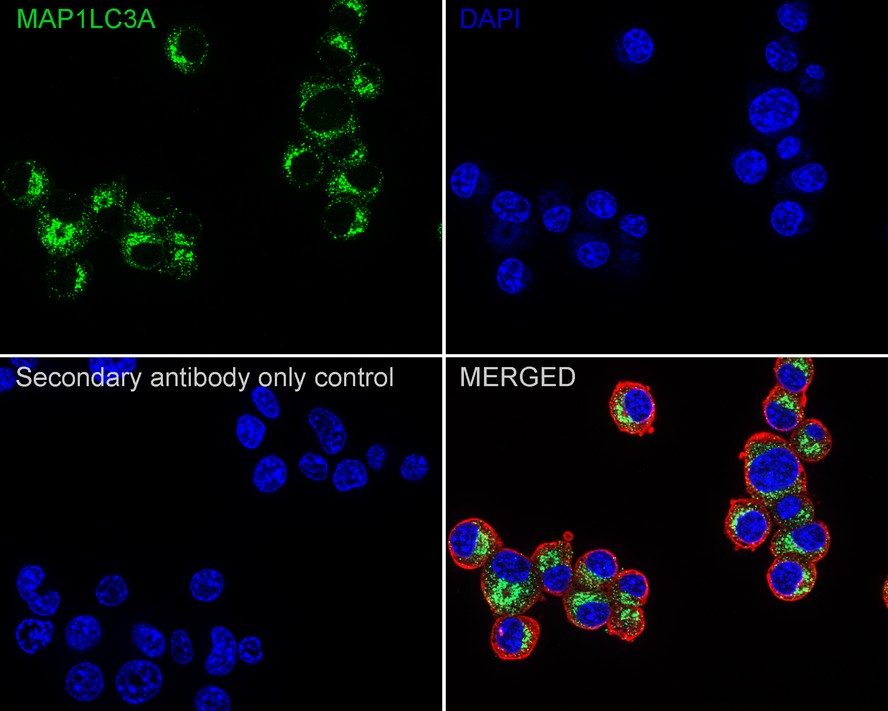
|
Fig3:
Immunocytochemistry analysis of Neuro-2a cells labeling MAP1LC3A with Rabbit anti-MAP1LC3A antibody (ET1609-26) at 1/100 dilution. Cells were fixed in 4% paraformaldehyde for 15 minutes at room temperature, permeabilized with 0.1% Triton X-100 in PBS for 15 minutes at room temperature, then blocked with 1% BSA in 10% negative goat serum for 1 hour at room temperature. Cells were then incubated with Rabbit anti-MAP1LC3A antibody (ET1609-26) at 1/100 dilution in 1% BSA in PBST overnight at 4 ℃. Goat Anti-Rabbit IgG H&L (iFluor™ 488, HA1121) was used as the secondary antibody at 1/1,000 dilution. PBS instead of the primary antibody was used as the secondary antibody only control. Nuclear DNA was labelled in blue with DAPI. Beta tubulin (HA601187, red) was stained at 1/100 dilution overnight at +4℃. Goat Anti-Mouse IgG H&L (iFluor™ 594, HA1126) was used as the secondary antibody at 1/1,000 dilution. |
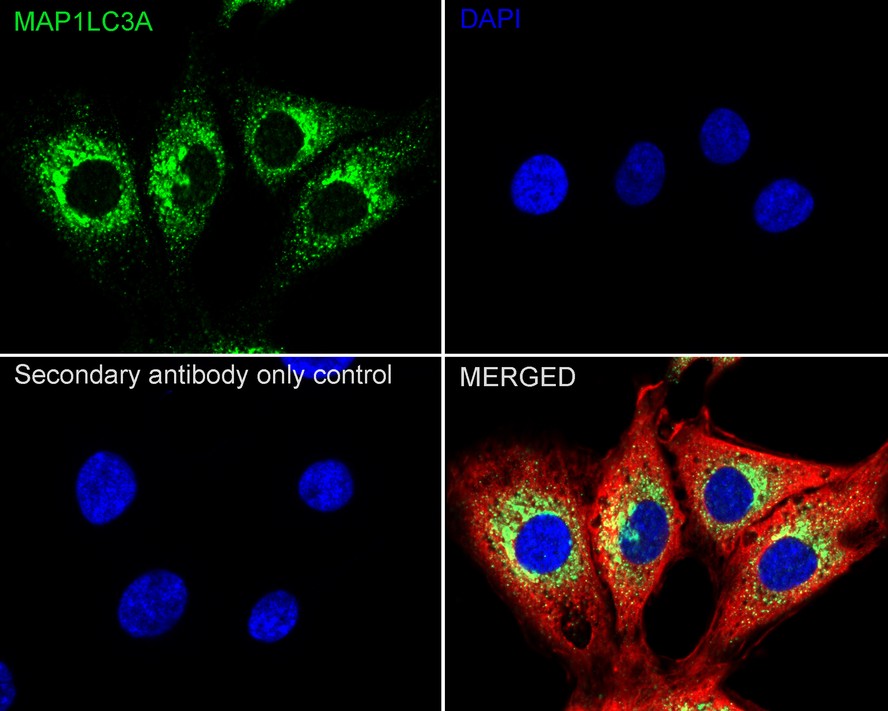
|
Fig4:
Immunocytochemistry analysis of C6 cells labeling MAP1LC3A with Rabbit anti-MAP1LC3A antibody (ET1609-26) at 1/100 dilution. Cells were fixed in 4% paraformaldehyde for 15 minutes at room temperature, permeabilized with 0.1% Triton X-100 in PBS for 15 minutes at room temperature, then blocked with 1% BSA in 10% negative goat serum for 1 hour at room temperature. Cells were then incubated with Rabbit anti-MAP1LC3A antibody (ET1609-26) at 1/100 dilution in 1% BSA in PBST overnight at 4 ℃. Goat Anti-Rabbit IgG H&L (iFluor™ 488, HA1121) was used as the secondary antibody at 1/1,000 dilution. PBS instead of the primary antibody was used as the secondary antibody only control. Nuclear DNA was labelled in blue with DAPI. Beta tubulin (HA601187, red) was stained at 1/100 dilution overnight at +4℃. Goat Anti-Mouse IgG H&L (iFluor™ 594, HA1126) was used as the secondary antibody at 1/1,000 dilution. |
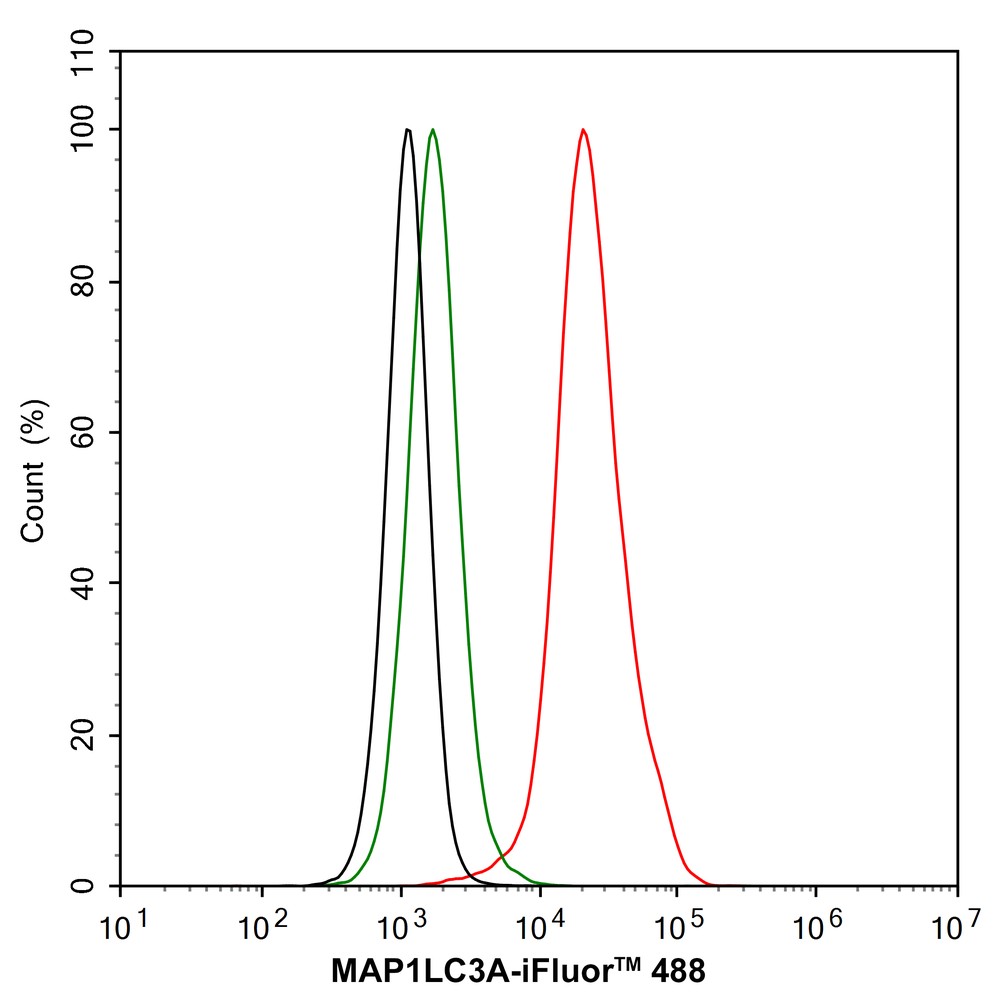
|
Fig5:
Flow cytometric analysis of SH-SY5Y cells labeling MAP1LC3A. Cells were fixed and permeabilized. Then stained with the primary antibody (ET1609-26, 1/1,000) (red) compared with Rabbit IgG Isotype Control (green). After incubation of the primary antibody at +4℃ for an hour, the cells were stained with a iFluor™ 488 conjugate-Goat anti-Rabbit IgG Secondary antibody (HA1121) at 1/1,000 dilution for 30 minutes at +4℃. Unlabelled sample was used as a control (cells without incubation with primary antibody; black). |
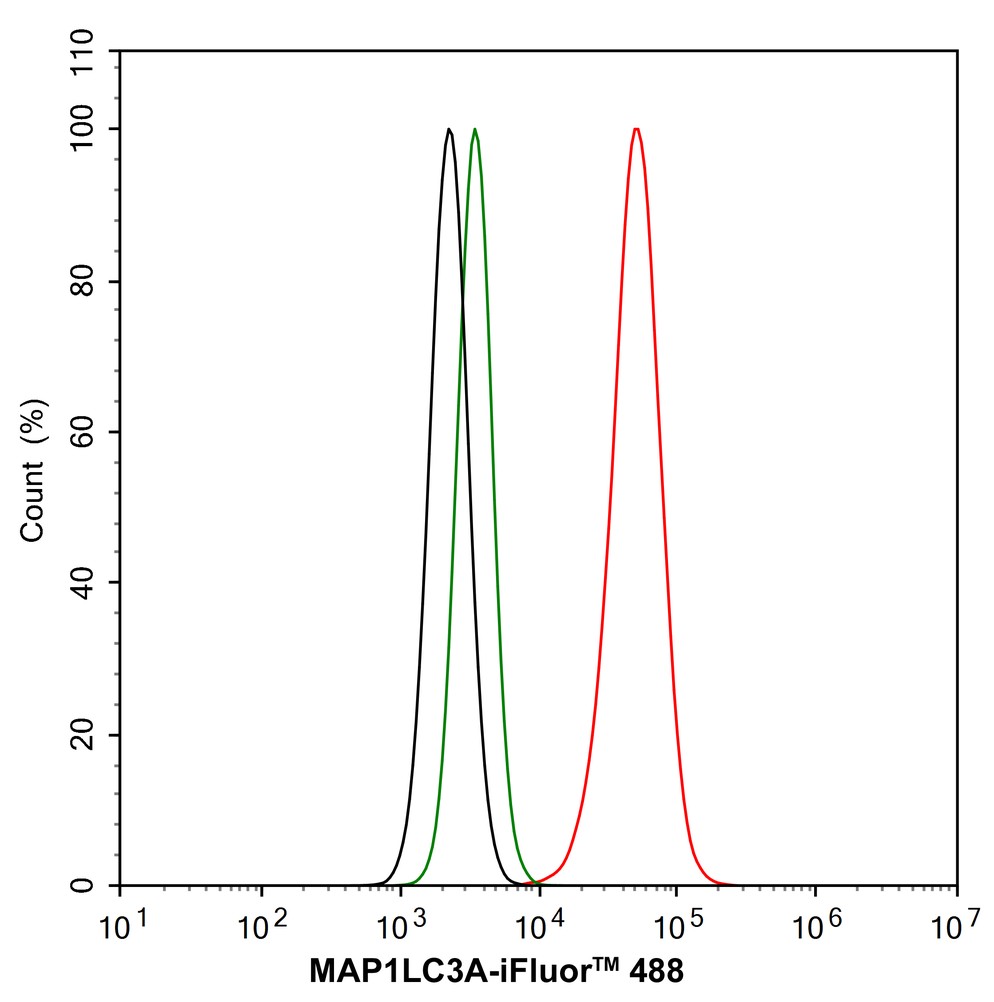
|
Fig6:
Flow cytometric analysis of Neuro-2a cells labeling MAP1LC3A. Cells were fixed and permeabilized. Then stained with the primary antibody (ET1609-26, 1/1,000) (red) compared with Rabbit IgG Isotype Control (green). After incubation of the primary antibody at +4℃ for an hour, the cells were stained with a iFluor™ 488 conjugate-Goat anti-Rabbit IgG Secondary antibody (HA1121) at 1/1,000 dilution for 30 minutes at +4℃. Unlabelled sample was used as a control (cells without incubation with primary antibody; black). |
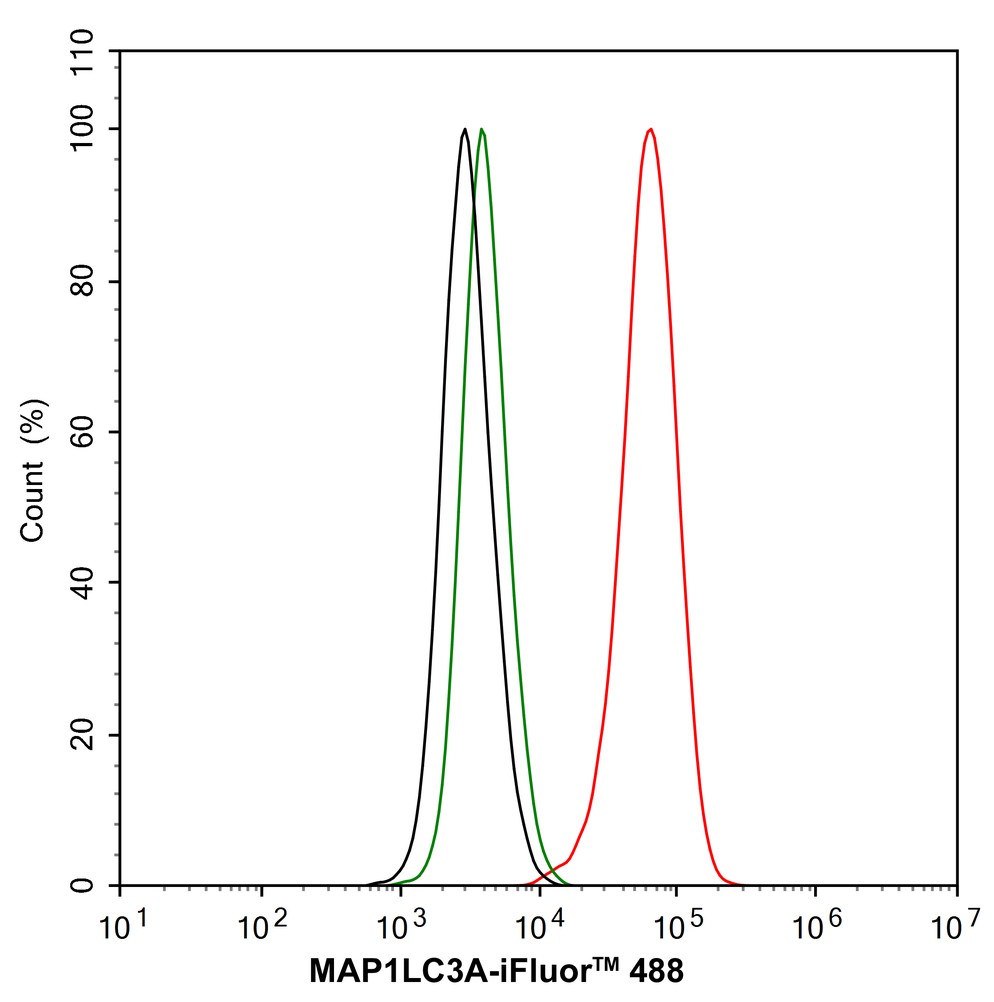
|
Fig7:
Flow cytometric analysis of C6 cells labeling MAP1LC3A. Cells were fixed and permeabilized. Then stained with the primary antibody (ET1609-26, 1/1,000) (red) compared with Rabbit IgG Isotype Control (green). After incubation of the primary antibody at +4℃ for an hour, the cells were stained with a iFluor™ 488 conjugate-Goat anti-Rabbit IgG Secondary antibody (HA1121) at 1/1,000 dilution for 30 minutes at +4℃. Unlabelled sample was used as a control (cells without incubation with primary antibody; black). |
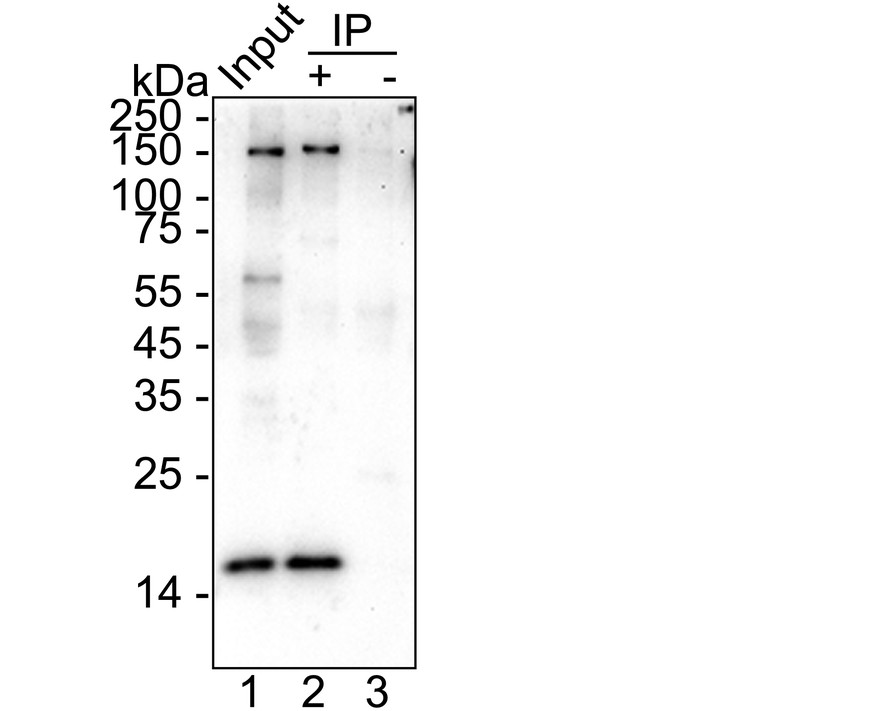
|
Fig8:
MAP1LC3A was immunoprecipitated from 0.2 mg C6 cell lysate with ET1609-26 at 2 µg/10 µl beads. Western blot was performed from the immunoprecipitate using ET1609-26 at 1/1,000 dilution. HRP Conjugated Anti-Rabbit IgG for IP Nano-secondary antibody at 1/5,000 dilution was used for 1 hour at room temperature. Lane 1: C6 cell lysate (input) Lane 2: ET1609-26 IP in C6 cell lysate Lane 3: Rabbit IgG instead of ET1609-26 in C6 cell lysate Blocking/Dilution buffer: primary antibody dilution (K1803) Exposure time: 3 minutes; ECL: K1801 |
Note: All products are “FOR RESEARCH USE ONLY AND ARE NOT INTENDED FOR DIAGNOSTIC OR THERAPEUTIC USE”.